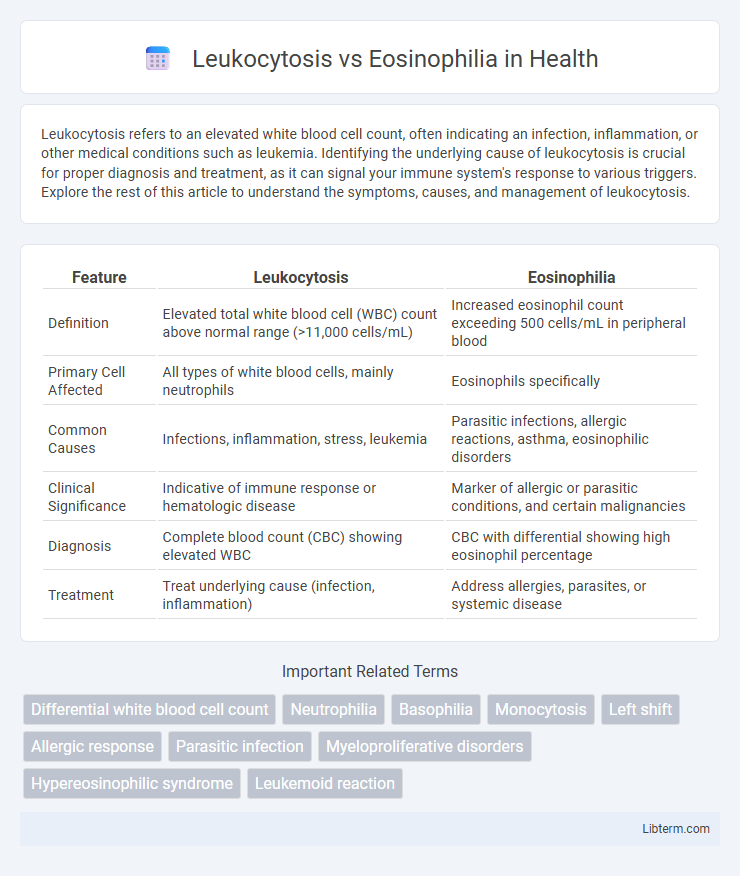Leukocytosis refers to an elevated white blood cell count, often indicating an infection, inflammation, or other medical conditions such as leukemia. Identifying the underlying cause of leukocytosis is crucial for proper diagnosis and treatment, as it can signal your immune system's response to various triggers. Explore the rest of this article to understand the symptoms, causes, and management of leukocytosis.
Table of Comparison
| Feature | Leukocytosis | Eosinophilia |
|---|---|---|
| Definition | Elevated total white blood cell (WBC) count above normal range (>11,000 cells/mL) | Increased eosinophil count exceeding 500 cells/mL in peripheral blood |
| Primary Cell Affected | All types of white blood cells, mainly neutrophils | Eosinophils specifically |
| Common Causes | Infections, inflammation, stress, leukemia | Parasitic infections, allergic reactions, asthma, eosinophilic disorders |
| Clinical Significance | Indicative of immune response or hematologic disease | Marker of allergic or parasitic conditions, and certain malignancies |
| Diagnosis | Complete blood count (CBC) showing elevated WBC | CBC with differential showing high eosinophil percentage |
| Treatment | Treat underlying cause (infection, inflammation) | Address allergies, parasites, or systemic disease |
Understanding Leukocytosis and Eosinophilia
Leukocytosis refers to an elevated white blood cell count, typically above 11,000 cells per microliter, indicating an immune response to infections, inflammation, or stress. Eosinophilia specifically involves an increased number of eosinophils, a subtype of white blood cells, often associated with allergic reactions, parasitic infections, and certain autoimmune conditions. Differentiating leukocytosis from eosinophilia requires analyzing complete blood count (CBC) results and clinical context to identify the underlying cause and guide appropriate treatment.
Key Differences Between Leukocytosis and Eosinophilia
Leukocytosis refers to an overall increase in white blood cell count, often indicating infection, inflammation, or leukemia, while eosinophilia specifically denotes an elevated number of eosinophils, commonly linked to allergic reactions, parasitic infections, or certain malignancies. Leukocytosis involves multiple types of white blood cells such as neutrophils, lymphocytes, and monocytes, whereas eosinophilia involves a selective rise only in eosinophils. The clinical implications differ as leukocytosis usually signals a broad immune response, whereas eosinophilia typically points to hypersensitivity or parasitic conditions.
Causes of Leukocytosis
Leukocytosis primarily results from infections, inflammation, stress, trauma, or hematologic disorders such as leukemia. It can also be caused by medications like corticosteroids and conditions like smoking or intense physical activity. In contrast, eosinophilia is specifically related to allergic reactions, parasitic infections, and certain autoimmune diseases.
Causes of Eosinophilia
Eosinophilia is primarily caused by allergic reactions, parasitic infections, autoimmune diseases, and certain malignancies, distinguishing it from general leukocytosis which involves an elevated white blood cell count due to infections or inflammation. Common triggers include asthma, drug hypersensitivity, helminthic infestations, and hypereosinophilic syndrome. Identifying the underlying cause of eosinophilia is crucial for targeted therapy, as its elevation reflects a specific immune response rather than a nonspecific leukocyte increase.
Clinical Manifestations: Comparing Symptoms
Leukocytosis commonly presents with fever, fatigue, and localized infections due to elevated white blood cell counts, especially neutrophils, while eosinophilia is frequently associated with allergic reactions, parasitic infections, and asthma, characterized by symptoms like wheezing, skin rashes, and gastrointestinal disturbances. Clinical manifestations of leukocytosis often include signs of systemic inflammation or bacterial infection, whereas eosinophilia symptoms reflect hypersensitivity or immune response to allergens and parasites. Differentiating these conditions relies on symptom patterns, with leukocytosis indicating acute or chronic infection and eosinophilia pointing toward allergic or parasitic etiologies.
Diagnostic Criteria and Laboratory Findings
Leukocytosis is characterized by an increased white blood cell count exceeding 11,000 cells/mL, primarily identified through a complete blood count (CBC) with differential showing elevated neutrophils or lymphocytes, whereas eosinophilia specifically involves an absolute eosinophil count greater than 500 cells/mL detected via CBC and peripheral smear indicating elevated eosinophils. Diagnostic criteria for leukocytosis often include clinical evaluation of infection, inflammation, or hematologic malignancies, while eosinophilia is associated with allergic reactions, parasitic infections, or certain malignancies confirmed by serum IgE levels and bone marrow biopsy in severe cases. Laboratory findings differentiate these conditions: leukocytosis presents with broad white cell elevation, whereas eosinophilia shows isolated eosinophil predominance, aiding targeted diagnosis and management.
Underlying Conditions Associated with Each
Leukocytosis, characterized by an elevated white blood cell count, is commonly associated with underlying conditions such as bacterial infections, inflammation, leukemia, and stress responses. In contrast, eosinophilia specifically involves an increased eosinophil count and is frequently linked to allergic reactions, parasitic infections, autoimmune diseases, and certain malignancies like Hodgkin lymphoma. Distinguishing these underlying causes is crucial for accurate diagnosis and targeted treatment strategies in clinical practice.
Treatment Approaches: Leukocytosis vs Eosinophilia
Treatment approaches for leukocytosis primarily focus on addressing the underlying cause, such as infections, inflammation, or bone marrow disorders, with therapies ranging from antibiotics to chemotherapy or corticosteroids. Eosinophilia treatment targets specific triggers like allergies, parasitic infections, or autoimmune diseases, often involving corticosteroids, antihistamines, or antiparasitic medications to reduce eosinophil levels. Both conditions require tailored interventions based on etiology, severity, and patient health status to effectively manage abnormal white blood cell counts.
Prognostic Implications
Leukocytosis, characterized by an elevated white blood cell count, often indicates an active infection or inflammation, serving as a prognostic marker for acute and chronic conditions such as sepsis or leukemia. Eosinophilia, marked by increased eosinophil levels, is typically linked to allergic reactions, parasitic infections, or certain malignancies, with prognostic implications depending on the underlying cause and severity, including risks for organ damage or hypereosinophilic syndrome. Differentiating between leukocytosis and eosinophilia aids clinicians in tailoring treatment strategies and predicting patient outcomes based on the specific immune response and disease etiology.
When to Seek Medical Attention
Leukocytosis, characterized by an elevated white blood cell count, warrants medical attention when accompanied by symptoms such as fever, unexplained fatigue, or signs of infection. Eosinophilia, marked by increased eosinophil levels, requires prompt evaluation if it occurs alongside allergic reactions, asthma exacerbations, or persistent respiratory issues. Timely consultation with a healthcare provider is crucial to diagnose underlying causes and initiate appropriate treatment.
Leukocytosis Infographic

 libterm.com
libterm.com